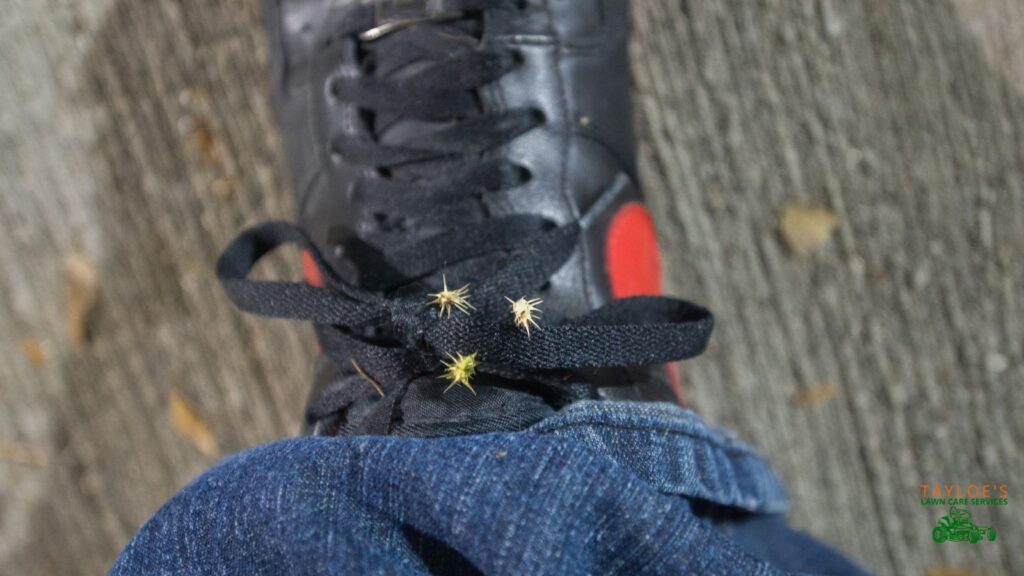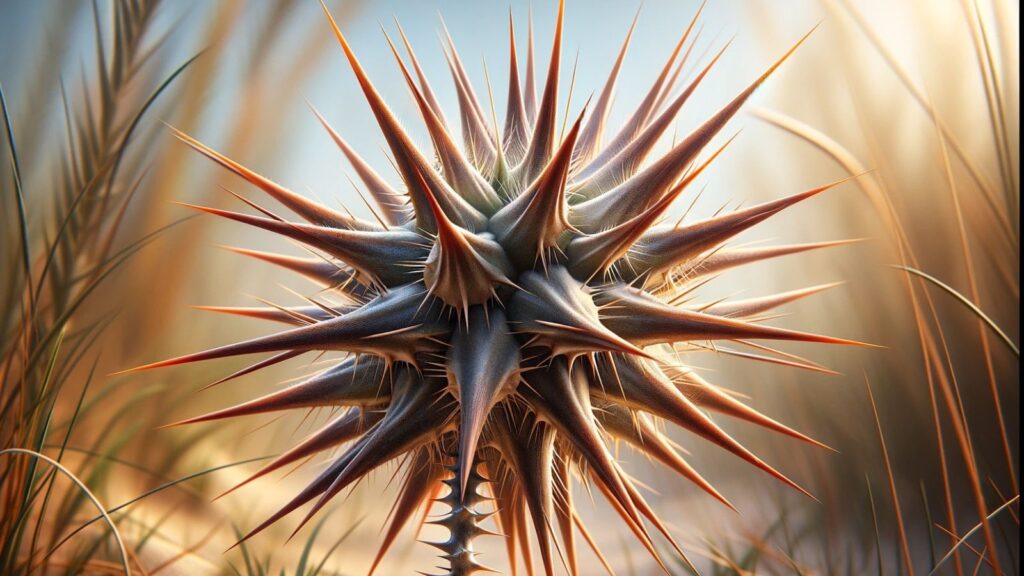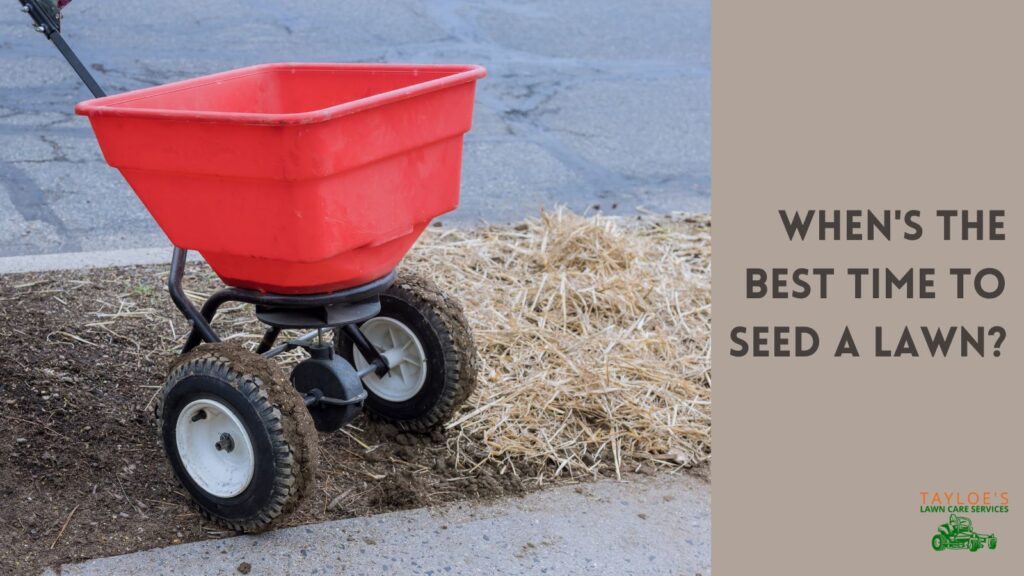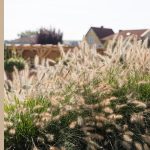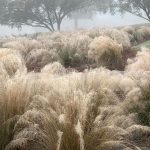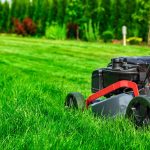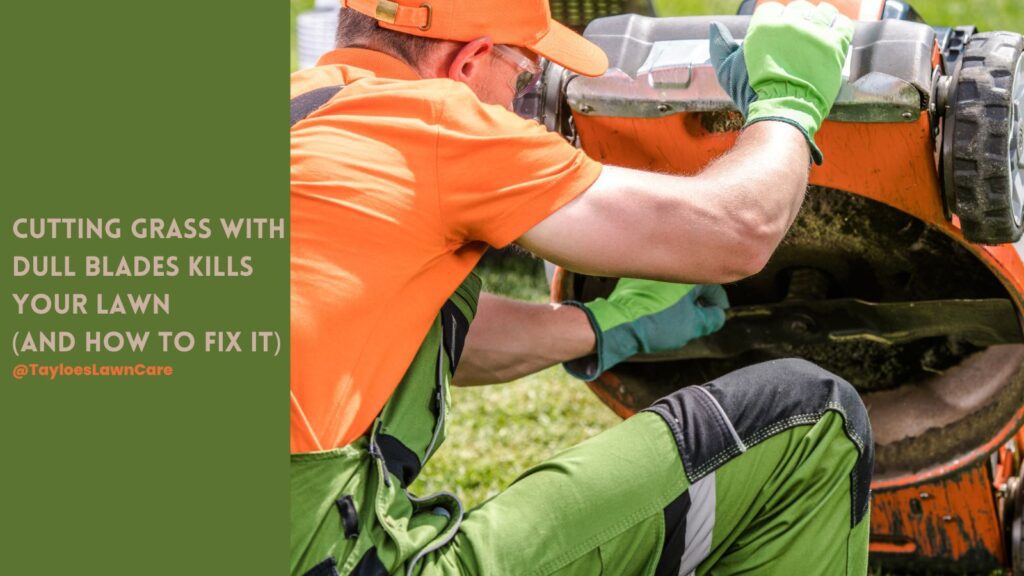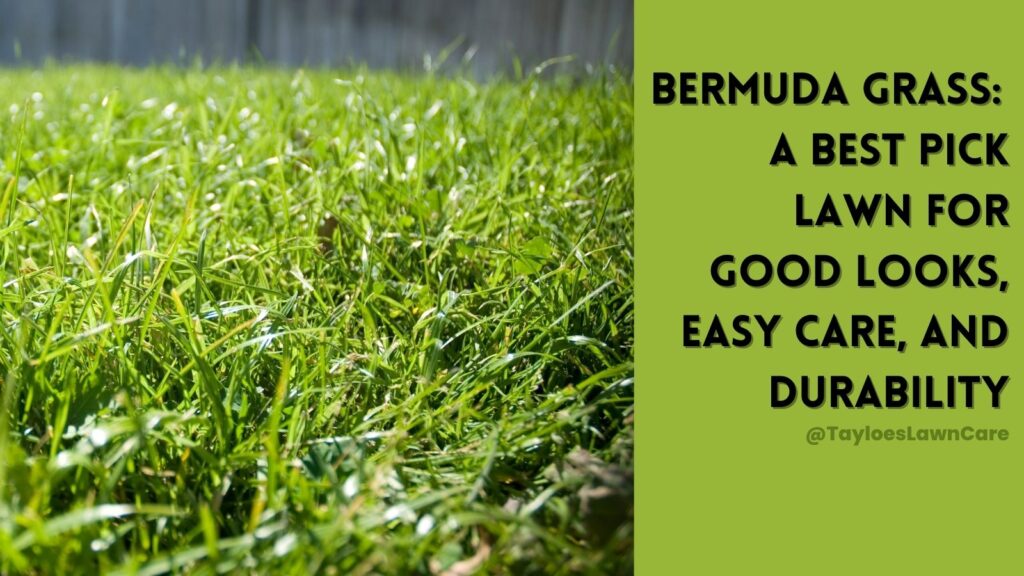Last Updated on: 8th November 2024, 06:52 am
Do you struggle with sand spurs, a.k .a. sand burs, in your yard?
If you are in North Carolina, you’re not suffering solo. These painful plants often mars the beauty and enjoyment of our lawns and gardens. These pesky, spiny nuisances not only detract from the aesthetic appeal of our green spaces but also pose a discomforting hazard to those who tread upon them.
At Tayloe’s Lawn Care Services near Windsor, NC, we understand the frustration and challenges that sand spurs bring to homeowners and gardening enthusiasts alike. My commitment to clients goes beyond mere lawn maintenance. I strive to provide comprehensive solutions and expert advice for effectively managing and eradicating these invasive plants.
With a deep understanding of local flora, our approach is tailored to the unique environmental conditions of our region, ensuring that your outdoor spaces remain beautiful and enjoyable throughout the year.
Recognizing the need for accurate information and effective strategies, we have developed this guide to battle the scourge of sandspurs. This guide is a testament to our team’s lawn care expertise and reflects our dedication to empowering our community with knowledge and practical solutions.
Whether you’re a seasoned gardener or a new homeowner grappling with your first lawn, this guide will thoroughly understand what sand spurs are, how to identify them, and the most effective methods for their control and removal. From preventive measures to safe and sustainable eradication techniques, we cover various topics, including the impact of sandspurs on pets, livestock, and people and specific considerations for dealing with these plants in Northeastern North Carolina.
What are Sandspurs (Sandburs)?
Sandspurs, scientifically known as Cenchrus longispinus, are grassy weeds notorious for their spiny seed heads. These seed heads, the ‘spurs’ in their name, easily attach to clothing, fur, and skin, causing discomfort and sometimes injury. The plant is relatively inconspicuous, often blending in with surrounding grass until its spiky seeds develop. The problem with sand spurs lies primarily in these seeds. They cause physical harm and contribute to the weed’s rapid spread. That combination makes it a persistent nuisance in lawns, gardens, and agricultural lands.
Understanding Cenchrus longispinus
Effective management of sand spurs requires understanding this lifecycle to time preventive and control measures appropriately.
Sandspurs are annual plants that complete their life cycle within a year. According to North Carolina State University’s plant database, they are invasive in the Tarheel State. The lifecycle of sand spurs includes a winter period, indicating that they can survive in a dormant state during colder months before resuming growth in warmer conditions.
This adaptability contributes to their persistence and difficulty in control. They typically germinate in late spring when soil temperatures rise, grow through the summer, and produce the problematic spurs by late summer or early fall. The seeds may stay viable in the soil for several years, creating a long-term challenge for eradication.
Botanical Description
Sandspurs belong to the Poaceae family, a large and diverse family of grasses. This annual grass is characterized by its slender, upright, and sometimes sprawling growth habit. The leaves are typically flat and linear, ranging from a few centimeters to over a foot in length. The most distinctive feature of Cenchrus longispinus is its seed heads, which are spiny burs. These burs are modified spikelets that encase the seeds, and their sharp spines are well-adapted for attaching to animals, clothing, and other surfaces, aiding in seed dispersal. The plant’s overall appearance is grass-like, making it somewhat challenging to identify until the burs develop.
Sandspurs thrive in sandy, well-drained soils, a key factor in their common name. They are particularly prevalent in areas with poor turf or ground cover, as these conditions reduce competition and allow the sandspurs to establish themselves more easily. This weed is commonly found in lawns, fields, roadsides, and other disturbed areas where the sandy soil receives plenty of sunlight.
Cenchrus longispinus is well-adapted to many environmental conditions but prefers warm climates. It is tolerant of drought, often giving it an advantage over more desirable, less drought-resistant lawn grasses and plants. Northeastern North Carolina meets those conditions, making sandspurs a common and troublesome presence. Effective management of sand spurs involves not only direct control of the plants themselves but also improving the health and density of the lawn to outcompete and prevent their establishment.
Sand Burs in Northeastern North Carolina
In Northeastern North Carolina, particularly in areas like Bertie County and Hertford County, sandspurs are a common and persistent issue. The region’s climate and soil conditions create an ideal environment for Cenchrus longispinus to thrive. These counties enjoy warm, humid summers and mild winters. Good for a nice lifestyle. But it also provides conducive growth for sand spurs. The prevalence is notably higher in areas with sandy soils, which are common in this part of North Carolina. That worsens when many lawns and open spaces in these counties may have patches of thin turf or disturbed soils under which sand spurs flourish.
Regional Challenges Presented by Sand Spurs
The challenges in controlling sand spurs in Bertie and Hertford Counties stem from environmental factors and land-use practices.
First, our warm climate extends the growing season of sand spurs, allowing them more time to germinate, grow, and spread. Second, the same rich soil that makes Bertie County an agricultural powerhouse also favors the growth of sand spurs.
In agricultural settings, empty fields with sparse vegetation can become hotspots for sandspur infestation. Similarly, residential areas with lawns that are not densely grown or are under stress due to drought, over-mowing, or poor nutrition are more susceptible to sandspur invasion.
Another challenge is the persistence of sandspur seeds in the soil. Even with effective control measures, the seeds can remain viable for several years. As a result, it requires ongoing vigilance and maintenance. It also makes preventive measures as crucial as direct control methods like herbicide application or mechanical removal.
For residents and landowners in Bertie and Hertford Counties, understanding these local conditions and challenges is key to implementing effective strategies for sandspur control. It requires a combination of good cultural practices to maintain healthy turf and timely and targeted interventions to manage existing sandspur populations.
How Do You Identify Sand Spurs?
Recognizing sandburs in your lawn or garden involves observing several key characteristics:
- Leaf Structure: Sandspur plants have narrow, linear leaves similar to common grass blades, making them somewhat difficult to distinguish in a lawn. The leaves are typically flat and can range from a few inches to just over a foot in length.
- Growth Habit: These plants often have a sprawling growth pattern but can also grow upright. They are generally not very tall, which allows them to blend in with the surrounding grass.
- Seed Heads (Burs): The most distinctive feature of sand spurs is their seed heads, which are spiny burs. These burs are typically green when young and turn brown as they mature. They are hard and spiky, easily attaching to clothing, fur, or skin.
- Root System: Sandspurs have a fibrous root system that is typical of grass species. It’s not usually visible unless the plant is uprooted.
- Seasonal Appearance: Sandspurs are most easily identified when they produce spiky seed heads, usually in late summer or early fall.
Common Mistakes
When identifying sand spurs, there are a few common misidentifications to be aware of:
- Confusing with Other Grasses: Sandspurs can be easily mistaken for other grass species due to their grass-like appearance. Paying close attention to the presence of spiky burs is key to correct identification.
- Misidentifying Seed Heads: Sometimes, other plants with spiky or bur-like seed heads can be mistaken for sandspurs. It’s important to note the specific structure of the sandspur burs – they are typically round, hard, and have multiple sharp spines.
- Overlooking Young Plants: Young sandspur plants, which haven’t yet produced seed heads, are often overlooked. Regular lawn monitoring, especially in the growing season, can help identify these plants early.
By familiarizing yourself with these identification tips and common mistakes, you can recognize and manage sandspurs in your lawn or garden more effectively. Early identification is crucial for controlling these weeds before they spread and become a larger problem.
Sand Spurs and Children
Safety Concerns
Sandspurs can be particularly troublesome for children, who often play in grassy areas where these weeds are found. The sharp spines of the sandspur burs can easily penetrate the skin, causing pain and irritation. In some cases, they can lead to more serious injuries, especially if they become embedded in the skin or if a child has an allergic reaction to them.
Preventative Measures
- Regular Lawn Inspection and Maintenance: Ensure your lawn is regularly inspected and maintained to control and prevent sandspur growth. A well-maintained lawn with thick grass is less likely to harbor sand spurs.
- Educating Children: Teach children about sand spurs and how to identify them. Please encourage them to wear shoes while playing outside, especially when sand spurs are present.
- Safe Play Areas: Designate specific play areas that are regularly checked and free of sandspurs. These might include fenced areas or parts of the yard where you can more easily control weed growth.
- Prompt Response to Injuries: If a child gets pricked by a sandspur, remove it carefully and clean the area with soap and water. Watch for signs of redness or infection and consult a healthcare professional if necessary.
- Clothing Considerations: Encourage children to wear protective clothing, such as long pants and closed shoes, when playing in areas where sand burs might be present.
By implementing these preventative measures and educating children about the risks of sandspurs, you can help ensure their outdoor playtime is safe and enjoyable. Regular lawn care and vigilance are essential in keeping play areas free from these harmful weeds.
Sandspurs and Pets and Livestock
Sandspurs pose a significant risk to pets and livestock due to their sharp, spiny seed heads. These burs can become entangled in fur and pierce the skin, causing pain and irritation. Sometimes, they can lead to more serious injuries or infections if not promptly addressed. Sand spurs can contaminate hay or grazing areas for livestock, leading to discomfort and potential oral or digestive issues if ingested.
Prevention and Treatment of Sand Burs
- Regular Lawn Inspection and Maintenance: Regularly inspect and maintain your lawn to prevent good conditions for sandspurs. These include proper mowing, watering, and fertilizing to encourage dense, healthy grass growth.
- Physical Barriers: In areas where sand spurs are prevalent, use physical barriers like fencing to restrict pet and livestock access.
- Regular Animal Checks: Regularly check your pets’ and livestock’s coats, especially after they have been in areas where sand spurs are known to grow. Please pay special attention to their paws, underbelly, and other areas where burs can easily attach.
- Prompt Removal of Burs: If you find sand spurs on your animals, remove them immediately using gloves. Be gentle to avoid causing additional discomfort or injury.
- Veterinary Care: If you see any signs of an infection or if an animal is in distress due to sand spurs, seek veterinary care promptly.
- Alternative Grazing or Exercise Areas: Provide alternative areas for grazing or exercise where sand spurs are absent.
By taking these preventive and responsive measures, you can protect your pets and livestock from the discomfort and potential harm caused by sandspurs. Regular lawn care and vigilance are key to minimizing these risks.
Getting Rid of Sand Burs in the Yard
Preventing sandspur growth is often more effective than eliminating them once they take hold. Key strategies include:
- Maintaining a Healthy Lawn: A dense, well-maintained turf is the first line of defense. Regular mowing, proper fertilization, and adequate watering encourage robust grass growth, leaving little room for sand spurs to establish.
- Soil Health: Improving soil conditions through aeration and adding organic matter can promote healthier grass growth and deter sand spurs.
- Bare Spot Treatment: Quickly address bare spots in your lawn, as these are prime areas for sandspur germination.
Mechanical Removal of Sand Burs
Physically removing sand burs can be effective, especially in smaller areas:
- Hand-pulling: This is most effective when the soil is damp, as removing the entire root system is easier. Wear gloves to protect your hands from the spiky burs.
- Tilling: Soil tilling can help remove existing plants in larger areas or pre-existing beds. However, this might also bring dormant seeds to the surface.
Chemical Control
Herbicides can be a powerful tool against sand spurs:
- Pre-Emergent Herbicides: Apply these in early spring to prevent seed germination. Products containing benefin, oryzalin, or pendimethalin are effective.
- Post-Emergent Herbicides: For mature plants, use a selective herbicide that targets grassy weeds. Always follow the manufacturer’s instructions for application rates and safety precautions.
Natural and Organic Options
For those seeking eco-friendly methods:
- Corn Gluten Meal: This natural pre-emergent can inhibit seed germination. Apply in early spring.
- Vinegar-Based Solutions: Acetic acid in household vinegar can be used as a non-selective organic herbicide. It’s most effective on young plants.
Timing and Consistency
Effective sandspur control requires timing and consistency:
- Pre-Emergent Application: Apply in early spring, before the soil temperature reaches about 52°F when sandspur seeds germinate.
- Post-Emergent Application: Use during active growth periods, typically in late spring or early summer.
- Regular Lawn Maintenance: Consistent lawn care throughout the year is crucial. Monitor your lawn regularly for signs of sandspur and address issues promptly.
Safety Precautions
When using chemical herbicides, safety is paramount:
- Read Labels Carefully: Always read and follow the instructions on herbicide labels for safe and effective use.
- Wear Protective Gear: Use gloves, long sleeves, and eye protection when applying herbicides.
- Keep Children and Pets Away: Ensure that children and pets stay off treated areas for the duration specified on the herbicide label.
When you combine these strategies and maintain a consistent lawn care routine, you can effectively manage and reduce the presence of sandspurs in your yard. Remember, persistence and timely action are key to keeping your lawn sandspur-free.
The Takeaway: Sand Spurs are Sticky to Manage
Effectively managing and controlling sand burs in your lawn requires knowledge, timely action, and consistent care. Understanding the nature of sand spurs, including their lifecycle, growth habits, and the conditions they thrive in, is crucial for effective control. If you implement a mix of preventive measures, mechanical removal techniques, appropriate chemical controls, and natural alternatives, you can significantly reduce the presence of these troublesome weeds in your yard.
The battle against sand spurs is not just a one-time effort but a continuous process. Regular lawn maintenance, including proper mowing, fertilization, and watering, is vital in preventing sandspur infestations. Additionally, being mindful of the safety of pets, livestock, and children when dealing with sandspurs is essential.
Adapting these strategies to the local environmental conditions will yield the best results for residents of Aulander, NC, and the surrounding areas of Bertie and Hertford Counties. Contact local resources like county extension services for further guidance and support.
At Tayloe’s Lawn Care Services, we are committed to our clients maintain a healthy and (hopefully!) sandspur-free lawn. You can enjoy your yard, free from the nuisance of sandspurs by following these tips. Don’t hesitate to contact us at 252.287.3376. We offer personalized advice and professional lawn care services. Together, we can keep your lawn beautiful, healthy, and enjoyable.
Author Profile

- Randy Tayloe is the COO of Tayloe's Lawn Care Service, LLC. He is a certified custom applicator, recognized by the North Carolina Department of Agriculture Pesticide Division. A native of Bertie County, NC, and graduate of Bertie High School, he wants to beautify his home county - one yard at a time.
Latest entries
 GardeningApril 1, 2025Fountain grasses add colorful foliage and movement
GardeningApril 1, 2025Fountain grasses add colorful foliage and movement GardeningMarch 21, 2025White cloud muhly grass growing guide
GardeningMarch 21, 2025White cloud muhly grass growing guide Lawn CareFebruary 25, 2025Should I mow every week?
Lawn CareFebruary 25, 2025Should I mow every week? Lawn CareFebruary 18, 202515 Simple early spring lawn care tips
Lawn CareFebruary 18, 202515 Simple early spring lawn care tips

